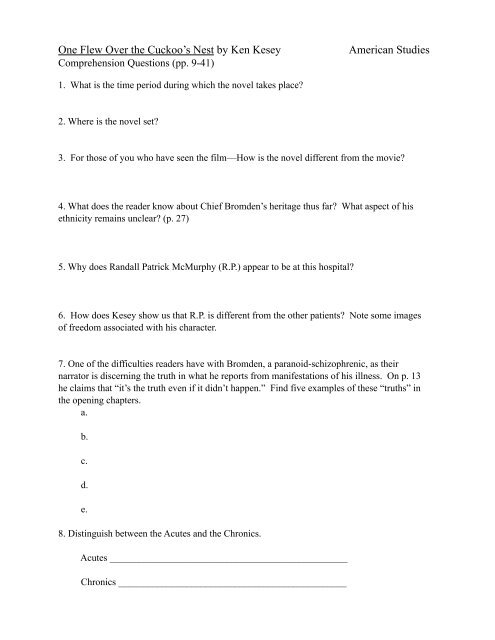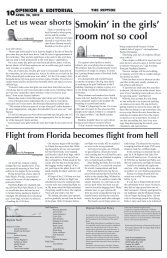Cuckoo Comprehension Guide 1
Cuckoo Comprehension Guide 1
Cuckoo Comprehension Guide 1
Create successful ePaper yourself
Turn your PDF publications into a flip-book with our unique Google optimized e-Paper software.
One Flew Over the <strong>Cuckoo</strong>’s Nest by Ken Kesey American Studies<br />
<strong>Comprehension</strong> Questions (pp. 9-41)<br />
1. What is the time period during which the novel takes place?<br />
2. Where is the novel set?<br />
3. For those of you who have seen the film—How is the novel different from the movie?<br />
4. What does the reader know about Chief Bromden’s heritage thus far? What aspect of his<br />
ethnicity remains unclear? (p. 27)<br />
5. Why does Randall Patrick McMurphy (R.P.) appear to be at this hospital?<br />
6. How does Kesey show us that R.P. is different from the other patients? Note some images<br />
of freedom associated with his character.<br />
7. One of the difficulties readers have with Bromden, a paranoid-schizophrenic, as their<br />
narrator is discerning the truth in what he reports from manifestations of his illness. On p. 13<br />
he claims that “it’s the truth even if it didn’t happen.” Find five examples of these “truths” in<br />
the opening chapters.<br />
a.<br />
b.<br />
c.<br />
d.<br />
e.<br />
8. Distinguish between the Acutes and the Chronics.<br />
Acutes _________________________________________________<br />
Chronics _______________________________________________
9. What are the three types of Chronic patients on the ward? Which of these designations does<br />
Bromden give himself?<br />
Chronics are labeled _______________, _________________, or<br />
_____________________. Bromden is a _______________________.<br />
10. In which war did Bromden participate? Find one of the three references to this war from<br />
the reading last night?<br />
11. What does McMurphy mean by the term “bull-goose”? Where does he claim to have been<br />
bull-goose before coming to the hospital? (p. 24)<br />
12. What does Kesey mean when he uses the term “Combine”? How does Bromden explain<br />
the Combine functions in American society? How is Mr. Taber made ready to return to<br />
society? (pp. 30 & 40)<br />
13. What “technique” does Nurse Ratched teach the first aide about how to deal with his hate?<br />
Why might this man understandably feel hatred? (p. 31)<br />
14. What do we notice about Bromden from his reporting of his high school football team’s<br />
trip to the cotton mill in California? Can we relate it to his present vision of the world? (38-40)<br />
15. What have we learned about other characters in the novel thus far?<br />
Nurse Ratched<br />
Billy Bibbit<br />
Dale Harding<br />
Ruckly<br />
16. Add other characters to your list. Categorize them as Chronics, Acutes, or Institutionalists.<br />
Take some brief notes about their defining characteristics.




